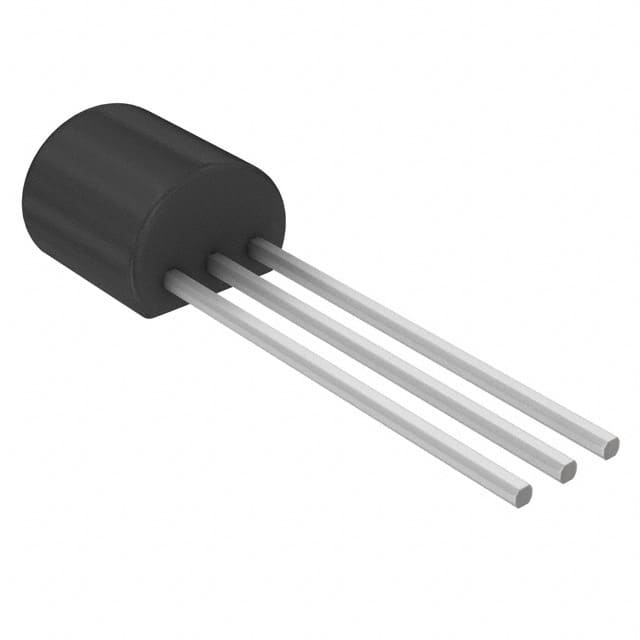J112-D74Z Product Overview
Introduction
The J112-D74Z is a versatile electronic component that belongs to the category of field-effect transistors (FETs). This entry provides a comprehensive overview of the product, including its basic information, specifications, pin configuration, functional features, advantages and disadvantages, working principles, application field plans, and alternative models.
Basic Information Overview
- Category: Field-Effect Transistor (FET)
- Use: Amplification and switching in electronic circuits
- Characteristics: High input impedance, low output impedance, voltage-controlled operation
- Package: TO-92 package
- Essence: Silicon-based semiconductor device
- Packaging/Quantity: Typically available in reels or tubes containing multiple units
Specifications
- Type: N-channel JFET (Junction Field-Effect Transistor)
- Maximum Drain-Source Voltage (VDS): 35V
- Maximum Gate-Source Voltage (VGS): -35V
- Maximum Continuous Drain Current (ID): 50mA
- Power Dissipation (PD): 350mW
- Operating Temperature Range: -55°C to 150°C
Detailed Pin Configuration
The J112-D74Z FET has three pins: 1. Gate (G): Controls the conductivity between the source and drain. 2. Drain (D): Connects to the positive supply voltage in most applications. 3. Source (S): Connects to the ground or common reference point.
Functional Features
- High input impedance allows for minimal loading of preceding stages.
- Low output impedance enables direct connection to subsequent circuitry.
- Voltage-controlled operation facilitates precise signal manipulation.
Advantages and Disadvantages
Advantages
- High input impedance minimizes signal degradation.
- Low output impedance ensures efficient signal transfer.
- Voltage-controlled operation offers flexibility in circuit design.
Disadvantages
- Susceptible to damage from electrostatic discharge (ESD).
- Limited maximum current handling capability compared to some other transistor types.
Working Principles
The J112-D74Z operates based on the principle of voltage-controlled conduction. When a voltage is applied to the gate terminal, it modulates the conductivity between the source and drain, allowing the device to amplify or switch electronic signals.
Detailed Application Field Plans
The J112-D74Z finds extensive use in various electronic applications, including: - Audio amplifiers - Signal processing circuits - Instrumentation systems - Switching circuits - Oscillator circuits
Detailed and Complete Alternative Models
Some alternative models to the J112-D74Z include: - J113-D74Z - J175-D74Z - 2N5457 - 2N5484
In conclusion, the J112-D74Z is a crucial component in electronic circuit design, offering high input impedance, low output impedance, and voltage-controlled operation. Its versatility makes it suitable for a wide range of applications, from audio amplifiers to signal processing circuits.
Word count: 448
Senaraikan 10 soalan dan jawapan biasa yang berkaitan dengan aplikasi J112-D74Z dalam penyelesaian teknikal
What is the J112-D74Z component used for in technical solutions?
- The J112-D74Z is a field-effect transistor (FET) commonly used for switching and amplification applications in electronic circuits.
What are the key specifications of the J112-D74Z?
- The J112-D74Z typically has a low drain-source on-resistance, high input impedance, and low input capacitance, making it suitable for various signal processing and control applications.
How can the J112-D74Z be utilized in power management systems?
- The J112-D74Z can be employed in power management systems to control the flow of current and voltage, enabling efficient regulation and distribution of power within electronic devices.
What are the typical operating conditions for the J112-D74Z?
- The J112-D74Z is designed to operate within specific voltage and current ranges, and its performance can be influenced by factors such as temperature and load conditions.
In what types of circuits is the J112-D74Z commonly integrated?
- The J112-D74Z is often integrated into audio amplifiers, switch-mode power supplies, motor control circuits, and other applications requiring high-frequency switching and low power dissipation.
How does the J112-D74Z contribute to signal processing and conditioning?
- The J112-D74Z's high input impedance and low input capacitance make it well-suited for signal processing and conditioning tasks, such as buffering and amplifying weak signals.
What are the thermal considerations when using the J112-D74Z in high-power applications?
- In high-power applications, proper heat sinking and thermal management are crucial to ensure that the J112-D74Z operates within its specified temperature limits and maintains reliable performance.
Can the J112-D74Z be used in radio frequency (RF) applications?
- Yes, the J112-D74Z's characteristics make it suitable for RF applications, including RF amplifiers and signal switching in communication systems.
Are there any common failure modes or reliability concerns associated with the J112-D74Z?
- While the J112-D74Z is generally robust, it is important to consider factors such as voltage spikes, overcurrent conditions, and static discharge to prevent potential failure modes.
What are some best practices for designing circuits with the J112-D74Z?
- Best practices include carefully considering biasing, ensuring proper decoupling and filtering, and adhering to recommended layout guidelines to optimize the performance and reliability of circuits utilizing the J112-D74Z.


